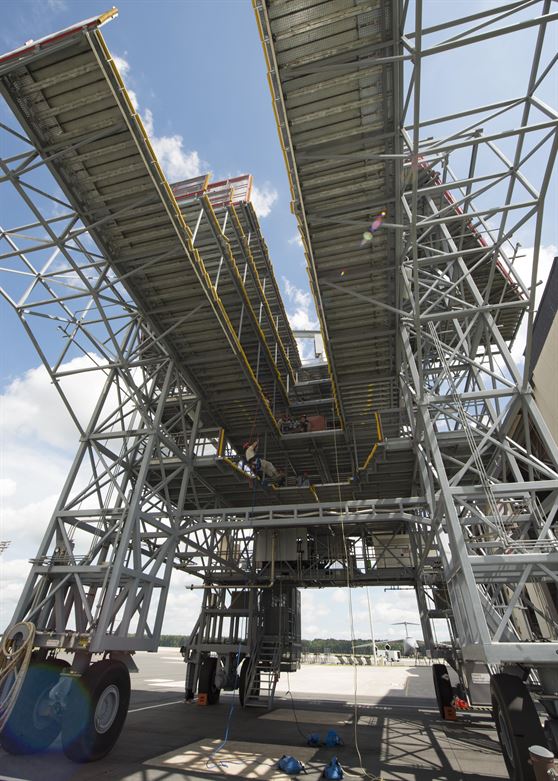Within the administration, there is a lot of excitement that the president’s proposal could earn bipartisan support and give a significant boost to the U.S. economy. But the president’s plan, still short on details, has raised concerns around the country about where the money will come from.
In his State of the Union address, Trump was careful to say that he will be asking Congress to produce legislation “that generates $1.5 trillion for the new infrastructure investment we need.” He continued that “every federal dollar should be leveraged by partnering with state and local government, and, where appropriate, tapping into private sector investment.”
Traditionally, infrastructure spending bills have enjoyed broad bipartisan support. During the president’s Tuesday address to Congress, it was one of a precious a few issues that drew enthusiastic applause from both Republicans and Democrats.
That is one reason Transportation Secretary Elaine Chao anticipates both sides of the aisle will find a way to move forward on Trump’s initiative. “Infrastructure impacts the vitality of our economy, our productivity, our quality of life,” she said in an interview with Michigan’s WPBN. “So I hope this will be a bipartisan effort.”
Watch the full interview with Secretary Elaine Chao.
Some Democrats have already expressed a desire to work with the president on infrastructure funding. While a number of Democrats are excited about the level of investment, they are worried about where the money will come from.
Oregon Democrat Rep. Kurt Schrader told KATU News that the issue of infrastructure is “huge,” noting the United States is going to be “out-classed by other countries.” At the same time, he is frustrated that so far there are no concrete details on the infrastructure plan. “I have heard no one, including the president last night, coming up with any plans to make sure this happens.”
Sen. Joe Manchin has reportedly already been in discussion with the White House. After a January meeting, the West Virginia Democrat said he was hopeful both Republicans and Democrats can work together on the issue. On Tuesday, Manchin was one of the few Democrats to stand and applaud the president’s $1.5 trillion infrastructure plan. He later told reporters that he is impressed with the size of the investment, but wonders how it will be funded. “I want to see where the money’s coming from and things to pay for it,” he said.
According to White House budget director Mick Mulvaney, the Democrats’ criticism is “fair” and the lack of detail is “by design.”
In the coming weeks, President Trump will send a summary infrastructure plan to Capitol Hill. Rather than a draft bill, White House officials say the president will outline the general principles and put together a team of cabinet officials, led by chief economic adviser Gary Cohn, to sell the plan to Congress.
From what is known about the president’s infrastructure plan, it will put heavy emphasis state and local government funding.
As it stands, state and local governments are responsible for the lion’s share of public infrastructure investment. The federal government contributes roughly 20 percent of the costs leaving local jurisdictions to pay for the remaining 80 percent or partner with the private sector. Based on what is known about the president’s infrastructure plan, the amount of federal funding would decrease to only 13 percent, leaving the states to raise the remaining portion of the money.
“The federal component [of the president’s $1.5 trillion infrastructure plan] is $200 billion, there’s no secret about that,” Mulvaney told Sinclair Broadcast Group. He explained the goal is “being able to take that $200 billion-worth of federal money and turn it into at least $1.5 trillion in new infrastructure.”
A portion of that $200 billion will be direct federal government investment, according to an outline of the plan released earlier this week. Another portion of the fund will provide a guarantee on projects in order to encourage investment.
Watch the full interview with Mick Mulvaney.
Turning $200 billion into $1.5 trillion may sound like weaving straw into gold, but according to Transportation Secretary Elaine Chao it can work if projects are prioritized and if state and local governments find “innovative and creative ways” to finance the projects.
“We hope the targeted approach will be a better one because we know pretty much where the specific projects are throughout the country,” she said. “So rather than spreading money around to everybody and perhaps hitting some of the lower priority projects, we want to really concentrate the federal [funding] on the high impact, high priority projects.”
Already, the Trump White House has a list of hundreds of shovel-ready projects submitted by industry lobbyists and state governors. The projects include highways and bridges, rural broadband, airports and waterways, and even a $45 billion oil and gas pipeline.
“Not everyone is going to be happy, unfortunately,” Chao said. “But its also a fact that we will not have …enough money at the federal level for everyone. That’s why we have to go the route of tapping the state and local government through their revenue raising sources as well as the private sector.”
Relying heavily on state and local governments to raise revenue to pay for new infrastructure is especially challenging for cash-strapped state governments. Experts in infrastructure finance have pointed out that if state and local governments had $800 billion or $1.3 trillion-worth of new revenue to raise, they probably would have done it.
The extent of America’s infrastructure problem was highlighted in a new report by the American Road and Transportation Builders Association, which found 54,259 of the nation’s 612,677 bridges are “structurally deficient” and one in three bridges are in need of some repair.
In Missouri, the state would have to find $4.2 billion to fix 12.5 percent of its structurally deficient bridges.
“We can patch them and inspect them and make sure they’re safe, but they take a lot more money and effort to keep them going,” Missouri Department of Transportation’s state bridge engineer Dennis Heckman told KRGC News. “If there was an increase of federal funding, for roads and bridges, obviously that would be good for Missouri and Missourians.”
Chao continued that there is “so much interest in the private sector in investing in infrastructure.” Having a $200 billion federal backstop against riskier projects could make them even more attractive.
“When we talk about private sector, we’re talking about pension funds. These are long-term investments,” the Transportation Secretary explained. “And these pension funds, private pension funds or public pension funds, they want to invest in collateral that will not walk away.” Investors, she continued, can “feel pretty secure” in putting their money in infrastructure that often has a lifespan of at least a half-century — and generally does not walk away.
One of the problems, according to Chao is that “right now there are 26 states that disallow the private sector from investing in public infrastructure.”
Texas is one of those states. In May 2017, state legislators struck down a bill that would have allowed private sector investors to build and maintain roads in exchange for the ability to collect tolls from road users. The bill was defeated by Republicans and Democrats alike who worried about high tolls and private companies profiting unfairly off local drivers.
In Michigan, the state legislature is also considering building toll roads to pay for new infrastructure investments, but the state’s federal lawmakers have thrown cold water on the idea.
“I’m not a fan of toll roads, I think that’s a really bad idea,” Democratic Sen. Debbie Stabenow told WPBN.
The Trump administration is also hoping that its push for deregulation will not only speed up the permitting process for infrastructure projects but also reduce the cost.
“Right now it can take 16 to 20 years to build a bridge or to [build] a highway,” Secretary Chao said. “Something has to be done with permitting.”
Mick Mulvaney stressed the importance of reviewing the permitting process and the federal regulations contribute to slow construction times.
“We pay for 20 percent, but we regulate 100 percent of it,” Mulvaney said of the federal government. The administration will be looking to cut those regulations, he said, to make the money invested in infrastructure “go further quicker.”
Mulvaney said that putting a dent in America’s trillion-dollar infrastructure deficit will depend on changing federal regulatory policy, something he questioned whether Democrats are willing to do. He remains optimistic, telling Sinclair Broadcast Group, “I actually think there’s a great deal of potential for a bipartisan solution on immigration and on infrastructure before the summer.”






